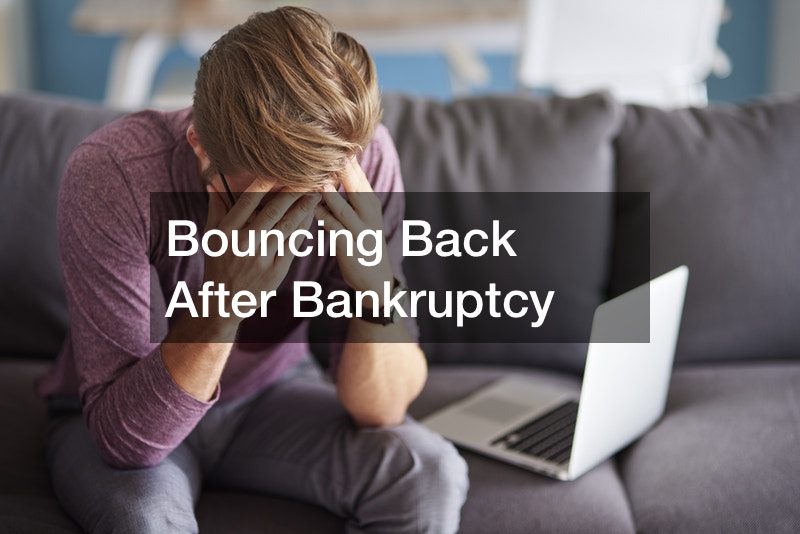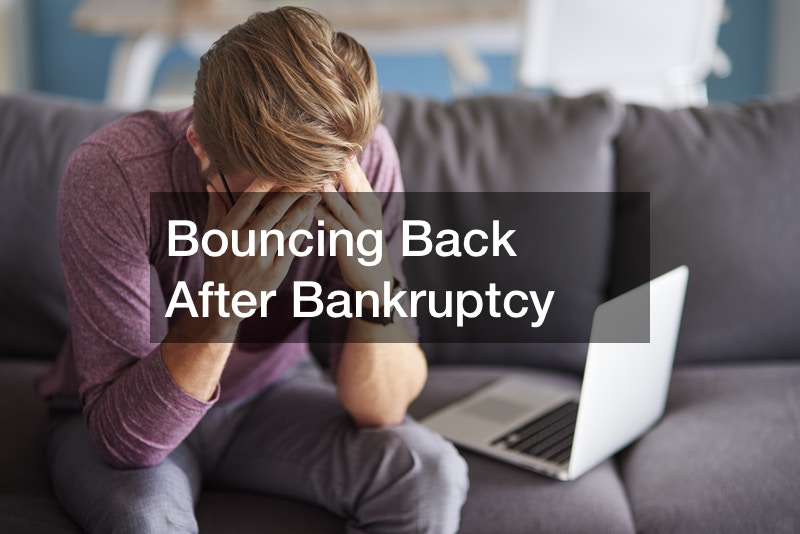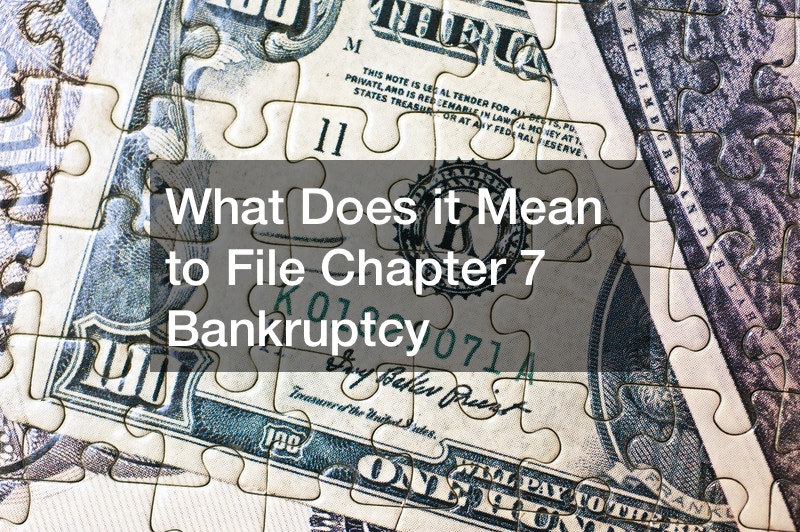

Filing bankruptcy is a life-changing decision. If you have filed bankruptcy or plan on filing bankruptcy, it is understandable that you would want to look ahead and learn about bouncing back after bankruptcy. The good news is, there is life after bankruptcy. When done right, bouncing back after bankruptcy can put you on much more stable financial ground.
How well you bounce back highly depends on taking the lessons you learned from past mistakes and applying them in the future. Ensuring that you take this second chance and do something good with it does take some planning.
Understand How You Got Into Bankruptcy In the First Place
During the frenzy of filing bankruptcy, there can be a lot of stress on your part. Your focus will be on hiring the best chapter 7 bankruptcy lawyers and not on why you got into bankruptcy in the first place. Down the road, after you have your legal help in place and you are going through the process, you must reflect on what got you to the financial trouble you are in right now.
People are driven to file bankruptcy for a wide range of reasons. Sometimes those reasons are out of your control. For example, medical bills have driven people to bankruptcy more than any other reason. Another big reason people are forced into bankruptcy is a divorce. Often, you lose a big chunk of your income to divorce and cannot keep up with your bills. Divorce lawyers see it happen all the time.
Some life events out of your control do push you into bankruptcy, but that is not the only way people wind up in bankruptcy. In some cases, it is just poor financial management. Part of bouncing back after bankruptcy and being successful is recognizing financial mistakes and making sure you do not repeat them.
There is a big difference between racking up medical bills because you had a medical emergency and racking up medical bills for plastic surgery procedures. The latter is poor financial planning. Moving forward, make bouncing back after bankruptcy a priority by getting your spending under control.
Make a Budget and Stick To It

If you and your bankruptcy attorney have decided that filing a Chapter 13 bankruptcy is the best option, you have already had to learn how to live on a budget because part of your pay is going to the Trustee to pay off your debt.
The good news is you are already learning how to live without that payment. It comes out of your paycheck and goes right to the Trustee. You may have had to make some changes to your spending. Eventually, your case will be over, and that money will no longer be taken out of your pay.
If you can live three years without it, that means you can put that money right into savings and still not miss it. This can be your new emergency fund. Bouncing back after bankruptcy by looking at budgeting differently is the easiest way to create a brighter financial future.
What if you filed a Chapter 7? Chapter 7 is a one and done deal. You do not pay off your debt, but you do not get to keep all your assets, either. You will not have the jump on budgeting that you can get with Chapter 13. Bouncing back after bankruptcy still means creating a budget and sticking with it. Budgeting in all bankruptcy cases is the easiest way to ensure bouncing back after bankruptcy is smooth sailing.
Here are some tips for creating a budget:
- Determine wants and needs. You need a home, electricity, food, health insurance, and transportation to get back and forth to work. Everything that does not fall into the need categories are really just wants. Creating a budget that is focused on bouncing back after bankruptcy has to be harsh to be effective.
- Where is your money going? If you are like most Americans, you really do not know where your money goes. You know the big payments, like mortgage payments, car insurance, and other recurring monthly bills, but the little things tend to eat up a budget. Track your spending for two weeks. Cut out the little expenses and watch how easy it is to stay on budget.
- Pay yourself. Setting up an emergency fund is necessary to avoid bankruptcy in the future. You cannot depend on credit cards for emergencies. If you need auto repair or have another emergency, you need to have the funds available. Pay yourself first each paycheck. Even if it is $20, it is a start. Put the money in a savings account.
Your financial health and wellness depend heavily on changing how you do things, including living on a budget. About 67% of Americans do not have a budget. It is imperative that you have one, otherwise bouncing back after bankruptcy may not be as successful as it could be.
Cash is King

During bankruptcy, credit cards are a no-no. It is a court process to take on any new debt. For example, your car breaks down, and you need to finance a new one during bankruptcy. Your attorney will have to file a request with the court for you to take on that new debt.
Most credit card companies will not approve you immediately after a bankruptcy is finished. Bankruptcy stays on your credit report for at least seven years. While you are waiting to get your financial footing again, make cash your go-to payment form. If you live on the budget that you set up, you will have savings to cover emergencies for the time being.
One of the most often asked questions about filing bankruptcy is, “will I ever be able to get credit again?” the answer is yes. Many subprime credit card companies will start contacting you immediately once your case is finished, but that does not mean you should take the offer.
Getting caught up in the same web of financial failure is not worth the small credit line they offer with the large interest that goes with it. It is best to use cash for a while, then start with a secured card from a reputable lender and rebuild your credit over time.
Bouncing back after bankruptcy can mean breaking old habits and the cycle of debt that got you into bankruptcy in the first place. Living within your means, saving for things you want, and learning to say no to credit offers can help improve your financial life.
Try Paying Yourself First

You may be so used to taking credit for everything that you are not sure how to save for those big expenses. A simple trick that can help with bouncing back after bankruptcy and learning how to live on a budget is to pay yourself first. Not pay yourself to save, but rather pay yourself for the things that you would normally make payments on.
Let’s say you really want some home remodeling services done. Get the quote, ask about financing and how much the payments would be, then make that amount of payment to yourself each month. Set up a separate account and make sure you make that exact payment to that account every month.
By doing this, you will save the money you need for the project, while saving a ton of money you would have paid to finance it. It may take time to save up the money, but it will create good financial habits, and more importantly, will keep you off the credit train.
Sometimes bouncing back after bankruptcy takes getting creative with your finances and learning how to be patient. You can use this approach to buy a new car, new furniture, any big purchases you would normally finance.
If You Take One Thing Away From Bankruptcy It is This
Many people who have filed bankruptcy, after evaluating the reasons they had to file bankruptcy in the first place, conclude that it was a lack of planning. The fact is, a lack of financial planning can leave you bankrupt.
Planning is the key to bouncing back from bankruptcy. After bankruptcy, every area of your financial life should have a plan. Estate planning to protect your assets. Tax planning to reduce tax liability. Budgeting to plan your monthly expenses.
Planning is the solution to bouncing back after bankruptcy and having the peace of mind that comes with knowing your financial life is in good shape. You need a plan for how you spend and grow your money.
Many people were never taught how to plan for a healthy financial future. Far too many people think you need to be wealthy to get financial planning help. Everyone needs to plan their financial future.
Here are some experts that can help you with every area of your finances:
- A CPA can help with tax planning.
- An attorney can help with estate planning, wills, and trusts.
- A financial planner can help you to set up retirement accounts and more.
You will have more income coming in after your bankruptcy is discharged. Each of these professionals is a worthy investment for your future. Bouncing back from bankruptcy usually means you will have more disposable income, so use some of it to enlist professional support.
When Do You Start Rebuilding Your Credit?

Most people coming out of bankruptcy are very eager to start rebuilding their credit. It is important to rebuild your credit, but a slow and steady approach is always best.
Bouncing back after bankruptcy the right way is vital to your future financial health. You do not want to take on too much debt too soon. A secured credit card is an easy way to make sure that you are limited in your spending.
Here is how a secured credit card works:
- You have to apply for a secured credit card. All the major cards like Discover and others have secured card options.
- You make a deposit. Some secured cards are issued with deposits as low as $200.
- Your credit limit is as large as the deposit that you make.
Let’s say you open a secured credit card and deposit $500. Your $500 is the security on the account. You will have $500 worth of credit on that card. The creditor does report to the credit bureaus without mentioning that the card is “secured.” This can help to raise your credit score. It can also help to ease you back into the credit world.
Your payments do not come from your security deposit (which does earn a small amount of interest). You make a monthly payment like you would with any other type of credit card. Of course, if you do not pay, they do keep your money.
Most people can rebuild their credit in less than the 7 years the bankruptcy stays on their credit report. Many people bouncing back after bankruptcy buy a house a few years after their bankruptcy is successfully discharged.
Bouncing back after bankruptcy is a process, but if you keep your eye on the prize, you will bounce back before you know it. Keep an eye on your credit report through one of the free services (don’t pay for credit monitoring, it’s a waste of money). If there are any discrepancies, immediately challenge them.
You will rebuild your credit, and you will have a brighter financial future if you stay on track.


